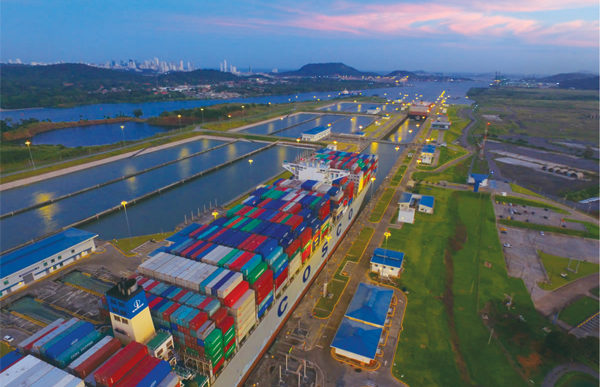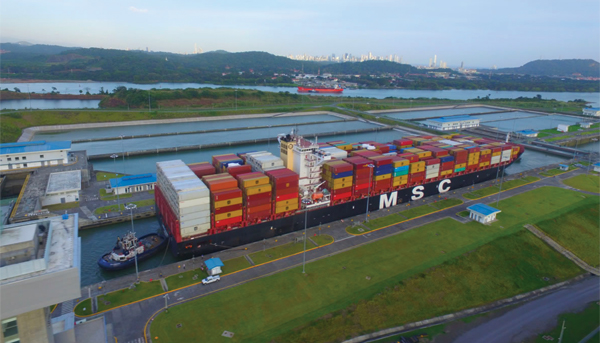Has the Panama Canal expansion changed anything?

During the buildup to the long-delayed opening of the expanded Panama Canal in mid-2016, the Panama Canal Authority, the government agency charged with managing, operating, and maintaining the canal, called the expansion a "marvel" and a "game changer." The authority's public relations operation went into overdrive, issuing press releases with headlines like "Inauguration of Expanded Panama Canal Ushers in New Era of Global Trade."
It's been more than two years since the expanded canal opened for business. Has it lived up to its billing? Many would agree that the $5.25 billion project qualifies as an engineering marvel. But whether the expansion is truly a game changer for international traders is less certain. Some industry segments have already seen a major beneficial impact, but for others, the jury is still out.
A DOUBLING OF CAPACITY
The Panama Canal expansion was designed to accommodate the growing number of container and bulk ships that are too large for the original infrastructure. The project included the construction of a set of new locks, on both the Atlantic and Pacific ends of the canal, that are 70 feet wider and 18 feet deeper than the locks in the original waterway. A massive excavation created a second, larger lane of traffic, essentially doubling the canal's capacity.
The original canal continues to operate, handling Panamax-size (meaning ships of the maximum length, width, and depth that can be accommodated by the original infrastructure) and smaller vessels. The "Neopanamax" size for the new lane is approximately 1,200 feet long, 168 feet wide, and 47 feet deep. The lane has handled containerships that are nearly that size and have capacities of more than 14,000 containers, measured in 20-foot equivalent units (TEUs). Some ships will still be too large, but the canal authority (known by the Spanish acronym ACP) says it can now accommodate 96 percent of containerships currently in service.
Panama, which has built its economy around the canal's role as an efficient route connecting Asia, North America, and Europe, will be the primary beneficiary of the expansion. Panama's government also sees the expansion as supporting the country's bid to be the primary trans-shipment hub for the Western Hemiäphere. U.S. businesses, too, stand to benefit, as about 60 percent of all cargo passing through the canal has an origin or destination in the United States.
WHO BENEFITS?
Perhaps the first to see direct benefits from the expanded canal were bulk ocean carriers. Liquefied natural gas (LNG) and other giant bulk vessels can now pass through Panama, reducing both transit times and operating costs compared with some of their traditional routes. This new user class contributed to the canal's 9.5-percent year-on-year increase in tonnage in its fiscal year 2018.
Container business is on the upswing too. The expanded canal has so far attracted 16 new container services, and in August 2018, the canal set a record for monthly container tonnage, said Argelis Moreno de Ducreux, head of ACP's Liner Services Segment, in an interview published in the canal's monthly e-newsletter. Since the expansion, she added, the average size of containerships transiting the waterway has increased by 28 percent.
ACP's figures indicate that some carriers are moving more containers with fewer, bigger ships, suggesting that carriers are seeing lower operating costs per container. That may be true, but some observers believe the expansion's net beneficial impact on carriers' costs may be marginal. For example, Panamax containerships pay transit tolls of as much as half a million dollars. Tolls are based on a ship's type, tonnage, and payload, so bigger ships pay more. In July 2016, the 10,000-TEU MOL Benefactor paid a one-way toll of nearly $830,000. To retain business, ACP has instituted discount programs for regular users, but with still-bigger ships on the way, one-way tolls of $1 million or more remain a possibility. Even if they operate fewer ships, carriers could still pay as much in tolls as they did before.
Faster all-water transit times from Asia compared with the Suez route are often cited as a cost advantage for carriers using the Panama Canal, but that's not necessarily the case, say some analysts. Theodore Prince, chief operating officer of the intermodal service company Tiger Cool Express, for one, expects bunker costs will be one of several factors determining whether big ships transit the Panama Canal. Fuel is the only significant variable cost for ship operators today, he says, and the biggest containerships "only save money when they're moving." Slow steaming to reduce fuel consumption, coupled with the long transit times on the Suez routes, generally is more economical for ship operators than the shorter transits via Panama, he contends. An international mandate requiring more-expensive low-sulfur fuel that takes effect in 2020 could make "even slower steaming" and longer transit times more cost-effective for carriers, he suggests.
Still, "cargo routing ultimately is a function of shippers' supply chain optimization, not of ocean carriers' linehaul economics," Prince wrote in a 2012 analysis titled "Panama Canal expansion: Game changer, or more of the same?" in DC Velocity's sister publication, CSCMP's Supply Chain Quarterly.
Some shippers do seem to be taking the canal expansion into account when formulating their long-term strategies. When a major U.S. retailer, which did not wish to be identified, was seeking a location for a new import distribution center a few years ago, the potential impact of the expansion was one of many factors it considered. The retailer concluded that the expansion could lead to more direct vessel calls at U.S. Atlantic and Gulf ports, potentially reducing its transportation costs compared with intermodal shipments over the West Coast and, in certain cases, shortening total transit times from Asia. In addition, the bigger ships transiting the canal would have more space for the retailer's growing import volumes. A seaport that could accommodate those ships was chosen as a home for the new DC.
It's too soon to know whether the retailer's forecast will prove accurate. But Moreno de Ducreux says the expansion is already benefiting U.S. shippers. Manufacturers and agricultural producers that export from the U.S. Midwest to Asia via the Mississippi River and the Gulf Coast have reduced their shipping costs by using the bigger ships that now pass through the canal, she contended in ACP's e-newsletter.

The picture is different on the inbound side. Even considering the time and cost of delivering containers from East Coast ports to inland destinations, it's generally faster and often just as cost-effective to serve the western two-thirds of the U.S. via intermodal service over the West Coast, Prince says. (The "battleground" is the Ohio River Valley, where intermodal and all-water costs and transit times are similar, thanks in part to improved rail service from East Coast ports.) West Coast intermodal offers more flexibility in terms of service and pricing, and for time-sensitive goods, more precision thanks to door-to-door service, he says. Faster transit times equate to lower inventory holding costs too. From a shipper's perspective, all-water to the East Coast via Panama may be best suited for commodities with year-round, steady demand, he notes.
The view from Panama is more upbeat. New container services attracted by the expanded canal are creating more opportunities for U.S. companies, says Demóstenes Pérez, supply chain business developer and strategist at Logistics Services Panama, a provider of warehousing, order fulfillment, and value-added services in Panama's Colón Free Zone. "The increase in 'New Panamax' vessels using the all-water route from Asia to the East Coast has brought ... new options for our customers to use inventory in Panama's logistics hub to ship product to the U.S. East Coast," he says. Some of the big ships stop at the Pacific end of the canal to load containers originating in Panama's free trade zone as well as agricultural products from Central and South America, he adds.
The increase in the size of the ships is requiring third-party logistics (3PL) companies to make adjustments, says John Knohr, managing director for DHL Global Forwarding, Panama and the Caribbean. "Since the vessels coming from Asia are bigger than they used to be, the number of containers we handle per bill of lading or per ship sometimes is double what we saw before." As a result, he adds, his company is accepting more outbound containers at one time into its Panama distribution center than in the past in order to prevent customers from facing demurrage penalties. If the ship is delayed, the longer wait times can potentially cause bottlenecks in the DC, he says.
PORTS PAY A PRICE
The scenario Knohr describes is not unique; capacity is a concern in many warehouses and DCs in Panama as well as around U.S. ports where Neopanamax ships unload. It's also become a huge issue for East Coast ports.
Realistically, few East Coast ports will play host to the big ships, says Dr. Bruce Arntzen, executive director of the Supply Chain Management Program at the Massachusetts Institute of Technology (MIT). Schedule constraints and the economics of ship and shoreside operations mean carriers will limit direct calls to a handful of ports—perhaps just two or three—and serve others via feeder services. This hub and feeder system with its reduced number of direct calls means that overall transit times are unlikely to improve. "Most of the delays on the steamship end happen on land, and the added trans-shipments mean more of the handling and handoffs that typically cause delays," he explains.
Ports such as Baltimore; Charleston, S.C.; Miami; Philadelphia; and Virginia, among others, have attributed increased container traffic to ships transiting the expanded canal. That new business comes at a price, however. To make themselves "big ship ready," East Coast ports required (depending on the port) such things as longer quays, bigger cranes that could stretch across 18 to 22 containers, deeper channels and berths, more container storage space and on-dock rail capacity, bigger turning basins, and higher bridges—witness the Port of New York/New Jersey's raising of the Bayonne Bridge to allow Neopanamax ships to pass under it.
Even ports that "hadn't been major destinations before ... are competing for federal funding for dredging and channel improvements that are mostly focused on accommodating the big ships," Arntzen observes. But given the inevitable reduction in direct port calls, he says, "they have to ask themselves whether it's a better strategy to become a great feeder hub instead."
Yet even if Neopanamax ships never call at a port that's invested in infrastructure improvements, that doesn't mean it's wasted money. The bigger ships will send more containers via feeder to those ports. Importers, exporters, and other players are sure to benefit from the efficiencies the infrastructure improvements will bring.
Prince says the Panama Canal expansion has produced one more benefit for shippers: It has made port labor on both coasts aware that "there's another coast shippers can use" if there's a strike. "They realize cargo on the West Coast can go to the East, and East Coast cargo can go west," he says. "Shippers and carriers can have a choice. They're not constrained by the size of the ship anymore."
Related Articles
Copyright ©2024. All Rights ReservedDesign, CMS, Hosting & Web Development :: ePublishing